Moments in Cuba
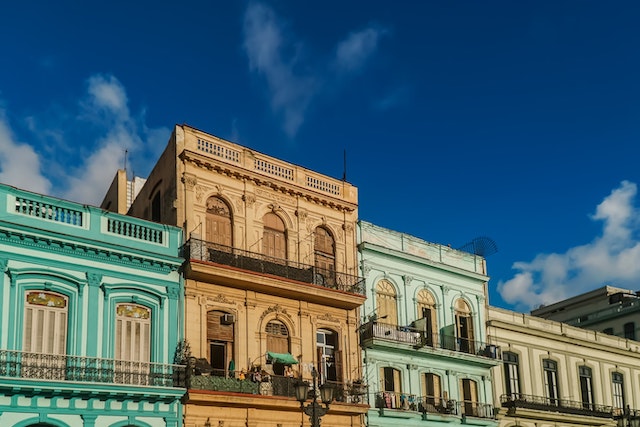
Cienfuegos
In the sunny courtyard of a café, a few blocks from Jose Marti Park, a slim man in a white guayabera and trousers, sings the ballads of my childhood in the Dominican Republic: Juan Tanamera and El Manicero. The white gear against his Ashanti chocolate skin is an arresting contrast. His voice is for the ears what the rum Havana Club Seleccion de Maestros is for the palate.
Listening to him and moving irresistibly to the sound of his voice filling the courtyard, is how we meet Livia and her two female cousins. They are sitting and moving at the table next to ours. Livia was born on the same day in October as my cousin and they share the same middle name, I learn as we chat while “Mr. Seleccion” takes a break.
Livia is only in Havana for a few days, she has been away for decades, she returned because of the recent death of her mother. She goes back to Tuscany where she works in a restaurant, the next day. Her dark eyes are full of longing at having to leave Cuba, and at the recent loss of her mother. “Eramos como hermanas,” they were like sisters because she was born when her mother was 17, she said. I imagine from the saudade she expresses at living away from Cuba that she was forced to leave.
When did she leave, why?
When did she leave, why? Was it during the 90s? During that painful economic crisis embodied in the sculpture of the woman on a horse with a fork and a cock in the Center of Old Havana. The period during which the country was beset by hunger that led some unfortunate women into prostitution? I don’t get to ask when Livia left or why it took her so long to return. Mr. Seleccion is back in front of the microphone, this time it’s an 80s Roberto Carlos tune. All five of us women get up, we move in a circle of joy belting out the chorus. As Mr. Seleccion emits his last note, Livia and her cousins wave good-bye.
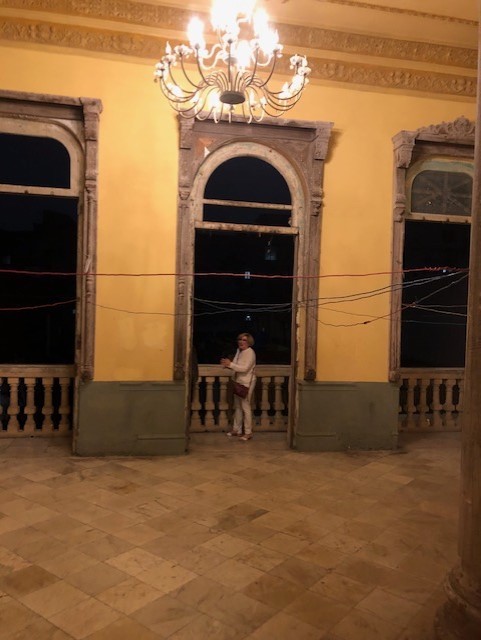
Havana
We push through the crowd and spot Benny, the local guide, waiting for us. It’s a few minutes after noon; we’re at the weekly festival of The Callejon de Hamel—an alley about the length of two city blocks— people of all ages and hues brush against us. Our official guide Rodrigo had warned Paula and I about pick pockets. Paula teaches at a University in Upstate New York, her husband is an attorney and part of the group of lawyers on this Continuing Legal Education program to Cuba.
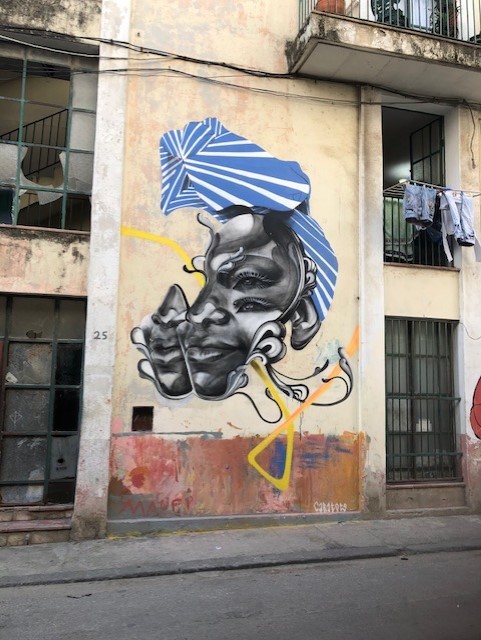
Paula and I follow Benny into a building that turns out to be a restaurant. Seated in a chair with an air of importance is a man Benny introduces as a painter, who is also a practitioner of Santeria, the religion characterized by the worship of African Orisha Gods. Benny explains that through syncretism Santeria developed into a dual system religion where each African Orisha has a corresponding Catholic saint, so that the Orisha God Chango, is also known as the Catholic Saint Barbara.
The painter, a stout gentleman possibly in his late 50s sits amidst a cacophony of gold, red and blue fabric, feathered stuffed birds, on the floor lies a small black doll in a checkerboard red and white dress, and a bunch of green bananas. Benny tells us, these objects around the painter are a combination of offerings to the Gods, and important symbols of the religion, especially the feathered birds. Birds are frequently sacrificed to the spirits in exchange for guidance. Benny ushers us away from the gentleman, who is now smoking a cigar; apart from an introductory greeting, he has not said a word.
We follow Benny out to the stage where the drummers stand, I am surprised to see that they are all women. Their hair is braided or covered with colorful West African style geles. Their palms pounding on the conga drums, yield mesmerizing beats that make the crowd shake. Everyone is dancing and singing along with the young woman in front of the drummers.
Never mind that the lyrics are not in Spanish, everyone there seems to know them. I imagine the language is the language one of our Cuban lecturers said was brought over by the first shipment of enslaved men in 1518 and remained as part of Cuba’s musical heritage.
Never mind that the lyrics are not in Spanish, everyone there seems to know them.
The next day we walk in the neighborhood of Vedado, where my Casa Particular is located, trying to find the historic Coppelia Ice Cream Parlor. I am eager to try some of the featured flavors, guava, passion fruit and coconut. When we arrive, we are disheartened to see a line blocks long that ends outside the park. It’s lunch hour and the sun is particularly potent. The woman managing the line notices that we’re speaking English, she comes up to us and guides us to the front of the line and into the air-conditioned parlor.
It takes a while for things to register— because we have CUCS, the currency that is valued at a higher rate than the Cuban peso— we do not have to wait. The Cuban natives are left outside in the merciless heat. We are mortified, this all smacks of discrimination.
We are mortified, this all smacks of discrimination.
Hours later Rodrigo tries to assuage our guilt, “you’re being here is good for the Cuban economy,” he says. I remain unpersuaded, maybe because Paula tells me that she heard that blacks were not allowed to buy ice cream at the Coppelia until after the revolution.
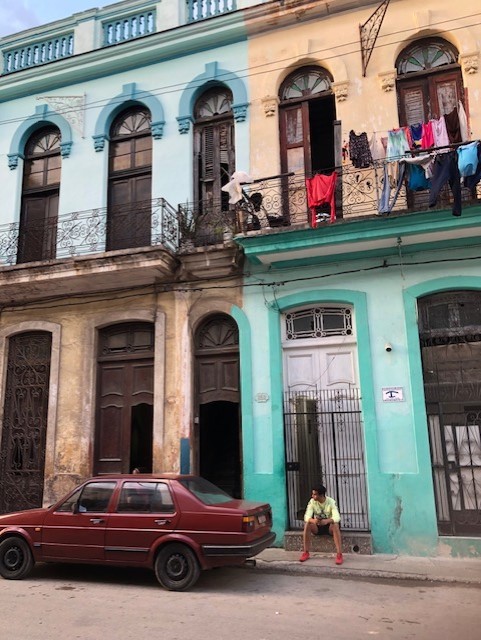
Pinar del Rio
“Aqui no se Rinde Nadie… Lastima no Vive Aqui.” “No one Gives up, Here. Pity does not Dwell Here.” These are the welcoming phrases at the entrance of Casa Graba Down, in Pinar del Rio. Exhibited inside are paintings of cats, dogs, and cocks in bursts of turquoise, pink and yellow. The paintings are creations of the members, who have Down Syndrome, and their art instructors.
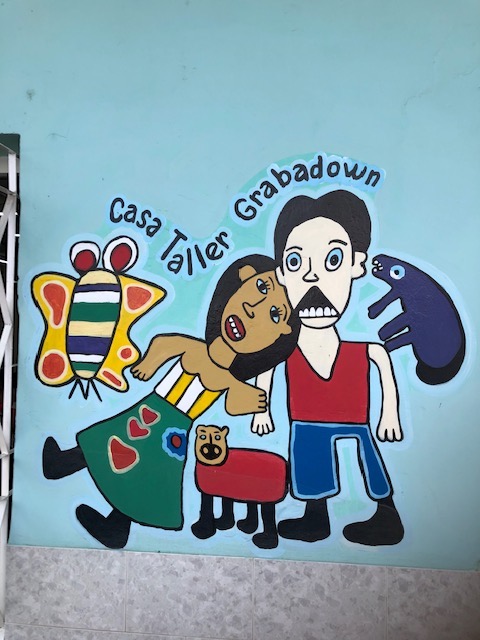
The co- founder of the center, the father of a young woman with Down Syndrome, invites us to a corto. We take sips of the strong coffee in diminutive cups— the ice breaker at Cuban gatherings.
Seven dark haired maidens, in black bodysuits and pink satin tutus, and one knight, dance on a stage. These young people’s bodies may not be the sculpted specimens we saw at the Alicia Alonso theater in Havana a few nights ago, but their focus and attempts at precision in movement, is no less admirable.
After their performance, one of the fathers tells us it all started when a group of parents seeking to find productive outlets for their children’s intelligence gathered and began to meet in a neighborhood building. It grew into Casa Graba Down offering art, dance, and theater. The participating members range in age from 12 to 44; the professionals who work with them are graduate students in education; their experience at the Casa is the substance of their theses. The Cuban government helps somewhat with materials: threads, cloth, paint.
They hate leaving here”
“They hate leaving here,” a mother of one of the members said. “Other cities across Cuba want to replicate the project.” I can relate, I myself would love to replicate the project in the Bronx where I live. My son has profound autism and a dream come true would be a space for him and other young people with autism to come and just be themselves. But I don’t share this with her, it’s not the moment.
Before we leave the maidens and the knight on stage perform another dance. They move with grace and self-confidence. Seeing what these intrepid parents have accomplished in Pinar del Rio fills me with a sense of possibilities for my son. These young people did not evoke pity in me, but a fighting spirit that knows that life is about growing, reaching, and overcoming. I saw this spirit in the eyes of resilient people all over Cuba.

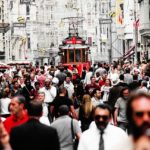


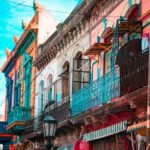

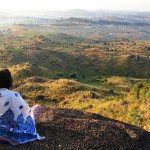


Loved Cuba and hope to go back. Nice to hear your more recent perspective on it too. Guantanamera (or “the woman from Guantanamo”) is a beautiful song. <3
Thank you Eva, I had a lot of fun writing it.
Very interesting article. Thank you!
Eva